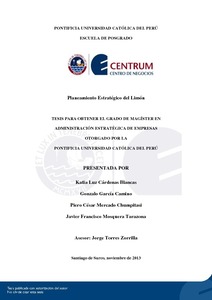| dc.contributor.advisor | Torres Zorrilla, Jorge | |
| dc.contributor.author | Cárdenas Blancas, Katia Luz | es_ES |
| dc.contributor.author | García Camino, Gonzalo | es_ES |
| dc.contributor.author | Mercado Chumpitasi, Piero César | es_ES |
| dc.contributor.author | Mosquera Tarazona, Javier Francisco | es_ES |
| dc.date.accessioned | 2017-06-01T18:08:31Z | |
| dc.date.available | 2017-06-01T18:08:31Z | |
| dc.date.created | 2013 | |
| dc.date.issued | 2017-06-01 | |
| dc.identifier.uri | http://hdl.handle.net/20.500.12404/8724 | |
| dc.description.abstract | El presente Plan Estratégico está centrado en el desarrollo del Limón hacia el año
2023. Las dos variedades cultivadas en Perú (i.e., Sutil y Tahití), cuentan con características
muy particulares que históricamente han orientado su consumo al mercado interno, sin
embargo esto puede empezar a cambiar rápidamente gracias al creciente interés mundial por
la gastronomía peruana y la difusión de bebidas de bandera como el pisco sour. Los
principales objetivos de este Plan son incrementar el consumo interno en 50% respecto al año
2013 y ubicar al Limón dentro de los cinco principales exportadores latinoamericanos. Perú
cuenta con una alta variedad de recursos naturales, fuerte demanda de educación, estabilidad
política, aumento de la preocupación por la responsabilidad social y la sostenibilidad, así
como una economía creciente. Sin embargo, el consumo interno del Limón se encuentra
estancado, las hectáreas destinadas a este cultivo se han venido reduciendo en las últimas
décadas. La industria del Limón se apoyará en el impulso del Gobierno hacia los proyectos de
inversión pública y privada en obras de irrigación y en general a la infraestructura que
soporte el crecimiento de la agroexportación.
El modelo aplicado para elaborar el Plan Estratégico del Limón hacia el año 2023 ha
sido el desarrollado por el Profesor Fernando D’Alessio. El proceso da como resultado las
estrategias a emplear como curso de acción. Se cuenta con ocho estrategias retenidas y nueve
estrategias de contingencia, las cuales aseguran la implementación de los objetivos de largo
plazo definidos, procurando además un equilibrio entre el desarrollo de la demanda interna, el
impulso a la exportación con apoyo en los nuevos tratados internacionales, la generación de
desarrollo económico y social para las regiones que lo cultivan y la explotación responsable
de los recursos naturales | es_ES |
| dc.description.abstract | Two main varieties of lemon cultivated in Peru are Limón Sutil and Limón Tahiti.
These have very distinctive features which, historically speaking, have highly impulsed
domestic market; however, this tendency may show a sudden variation due to the worldwide
growing interest in Peruvian gastronomy and the promotion of national drinks; such as the
Pisco Sour. The current strategic plan is focused on the development of Lemon Industry in
Peru towards 2023. This plan mainly aims to increase the percentage of the fruit’s domestic
consumption in 50% compared to 2013, and place its market among the five main Latin
American exporters of this citric fruit.
In the last years, Peru has gained prestige for its wide range of natural resources, a
high educational demand, political stability, increasing interest for social responsibility and
sustainability, as well as a growing economy. However, the domestic consumption of lemon
has shown to be hindered and the number of hectares destined for the production of it has
shown a decreasing tendency in the last decades. In spite of this, the lemon industry will soon
be supported by the Governmental boost towards the development of PPPs (public-private
partnerships) aiming to improve irrigation and infrastructure processes that support the
growth of agro-exports.
The model used on the elaboration of this strategic plan for 2023 has been developed
by Professor Fernando D’Alessio. The process gives way to the identification of strategies to
be used as an action plan; 8 retained ownership and 9 contingency strategies, which ensure
the implementation of long-term well-defined objectives and aim to keep balance among the
development of domestic demand, exports boost with the help of new international trade
agreements, and the generation of economic and social development for regions that cultivate
and export their natural resources responsibly | es_ES |
| dc.language.iso | spa | es_ES |
| dc.publisher | Pontificia Universidad Católica del Perú | es_ES |
| dc.rights | info:eu-repo/semantics/openAccess | es_ES |
| dc.rights.uri | http://creativecommons.org/licenses/by-nc-nd/2.5/pe/ | * |
| dc.subject | Limones -- Comercio -- Perú | es_ES |
| dc.subject | Productos agrícolas -- Comercio -- Perú | es_ES |
| dc.subject | Planificación estratégica | es_ES |
| dc.title | Planeamiento estratégico del limón | es_ES |
| dc.type | info:eu-repo/semantics/masterThesis | es_ES |
| thesis.degree.name | Maestro en Administración Estratégica de Empresas | es_ES |
| thesis.degree.level | Maestría | es_ES |
| thesis.degree.grantor | Pontificia Universidad Católica del Perú. CENTRUM | es_ES |
| thesis.degree.discipline | Administración Estratégica de Empresas | es_ES |
| renati.discipline | 413307 | es_ES |
| renati.level | https://purl.org/pe-repo/renati/level#maestro | es_ES |
| renati.type | https://purl.org/pe-repo/renati/type#tesis | es_ES |
| dc.publisher.country | PE | es_ES |
| dc.subject.ocde | https://purl.org/pe-repo/ocde/ford#5.02.04 | es_ES |






